Ginger is a powerful medicinal herb and spice used for centuries to add flavor and healing properties to food. It’s an ancient root native to Southeast Asia but has spread worldwide and become a favorite in many cuisines. Ginger belongs to the Zingiberaceae family of plants, which also includes turmeric plant, cardamom, and galangal plant. Ginger is an incredibly versatile ingredient. It can be used to make tea, added to soups and stir-fries, or even enjoyed on its own. Its flavor is spicy, sweet, and slightly citrusy.
Ginger has several impressive health benefits. It can help to reduce nausea and motion sickness, ease muscle pain and soreness, reduce inflammation, improve the absorption of nutrients in the body and even fight bacteria. It’s no wonder that ginger has been used for centuries to aid in the treatment of many ailments.
Ginger is also an incredibly easy plant to grow. It requires minimal care and attention and can be grown both indoors and outdoors. Ginger is a rhizome, meaning that it grows via underground stems. Here is everything you need to know about growing and caring for ginger.
History and Origin of Ginger:
Ginger has been used for thousands of years to treat various ailments, including digestive problems and infections. In ancient Chinese medicine, ginger was known as a “universal remedy” because it was believed to have so many healing powers. In India, Ayurvedic medicine practitioners use ginger to aid digestion and reduce inflammation. It is also mentioned in the Bible and ancient Greek mythology.
Types of Ginger:
Ginger root is available in several forms. The most common are fresh ginger, ground ginger, dried ginger, and crystallized (candied) ginger. Fresh ginger can be found year-round in the produce section of your grocery store. Ground ginger is a powdered form that is used to add flavor to recipes. Dried ginger is often referred to as ginger powder and is usually used in baking. Crystallized ginger is candied ginger cooked in sugar syrup and can be eaten as a snack or added to recipes for sweetness and flavor.
Nutritional Benefits of Ginger:
Ginger contains vitamins A and C, magnesium, potassium, phosphorus, calcium, flavonoids, fatty acids, glycosides, and amino acids. The root is rich in antioxidants that can help protect against damage from free radicals. It also contains anti-inflammatory compounds that may help reduce inflammation associated with arthritis or other chronic conditions.
Health Benefits of Ginger:
Ginger is a versatile root used for centuries to treat many different illnesses. It contains numerous active compounds, including gingerols and shogaols, which have powerful medicinal properties.
Research suggests that consuming ginger can provide many health benefits. It may reduce inflammation, improve digestive health, relieve pain and nausea, fight viral infections and lower the risk of several diseases.
One of the primary benefits of ginger is its anti-inflammatory effects. Ginger contains active compounds such as gingerols and shogaols that are known to reduce inflammation in the body. This may help protect you from various conditions, including heart disease, diabetes, arthritis, and cancer.
Ginger can also aid digestion by increasing saliva production and promoting healthy gut bacteria growth. In addition, it may help relieve symptoms associated with indigestion, such as bloating or abdominal pain, due to its carminative effects.
Ginger is also renowned for its ability to relieve nausea and vomiting. Studies have found that ginger can reduce the severity of morning sickness, chemotherapy-related nausea, and postoperative nausea. It’s often used as a natural remedy for upset stomachs.
Finally, ginger has been shown to contain antiviral properties, which may help fight off infections caused by viruses such as colds and flu. Additionally, some research suggests that consuming ginger regularly can lower your risk of heart disease and stroke due to its antioxidant properties.
Overall, consuming ginger regularly provides numerous health benefits. It may reduce inflammation, improve digestive health and reduce nausea. Additionally, it may help to fight viral infections and lower the risk of several diseases. Therefore, eating ginger is a great way to ensure optimal health and well-being.

Using of Ginger:
Ginger can be enjoyed in many forms, including fresh root, ground powder, dried pieces, or as an extract. Fresh ginger can be grated or chopped into smoothies, stir-fries, and other dishes. Ground ginger adds flavor to soups and sauces while dried pieces are often used in tea blends or added to make ginger candy. Ginger extract can be taken as a supplement in capsule or liquid form.
Ginger is an incredibly versatile root that has been used for centuries to add flavor and healing properties to food. Not only does it have a distinct flavor, but it also provides numerous nutritional benefits and may even help boost health.
Fresh, dried, and powdered forms of the root are available at many grocery stores and natural health stores, while extracts can be taken in supplement form. Whether you’re looking to add some spice to your food or aiming to reap the medicinal benefits of ginger, there’s no denying its potential.
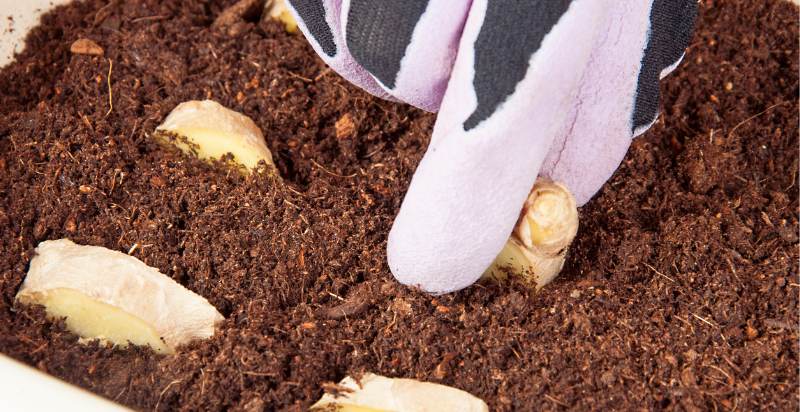
How to Plant Ginger?
Ginger is a popular spice that has been used for centuries in cooking and medicine. It is known for its distinctive flavor and aroma and its many health benefits. This article will cover everything you need to know about planting ginger – from selecting the right variety to harvesting your crop!
- Choosing the Right Variety: There are several varieties of ginger available in stores and online that vary in flavor, texture, size, and color. Before purchasing your plant material, it’s important to understand which type of ginger best suits your needs. If you want more pungent ginger with a spicy kick, look for a variety such as red or green fingerling. For a more subtle flavor, try yellow or white Thai ginger.
- Preparing the Soil: Ginger prefers soil that is rich in organic matter and has a pH range of 6.0-6.5. It’s important to prepare the soil before planting by adding compost or other organic material to increase water retention, drainage, and nutrient availability. You can also add fertilizer to ensure your ginger plants have access to all the nutrients they need during growth.
- Planting Ginger: Planting ginger is best done in early spring when temperatures are mild, and plenty of rain or irrigation is available. Choose a location with full sun exposure for at least 8 hours per day and dig holes about 6 inches deep for each rhizome piece you plan on planting. Place each piece in the hole and cover it with soil, patting it down lightly to ensure it is secure.
- Watering and Mulching: Ginger requires consistent moisture for optimal growth. Water your ginger plant deeply at least once a week to saturate the soil around the roots. To retain moisture, you can also mulch around each plant with organic matter such as leaves or straw.
- Harvesting: Harvesting ginger typically occurs 8-10 months after planting, depending on the variety chosen. When harvesting, make sure to dig up entire rhizome pieces (roots and any attached stems). If desired, you can store fresh ginger in a cool dry place or use it immediately in recipes!
Planting ginger is a rewarding experience that can provide you with delicious flavors and aromas for years to come. Your ginger plants will surely thrive with the right variety, soil preparation, watering, and mulching practices.
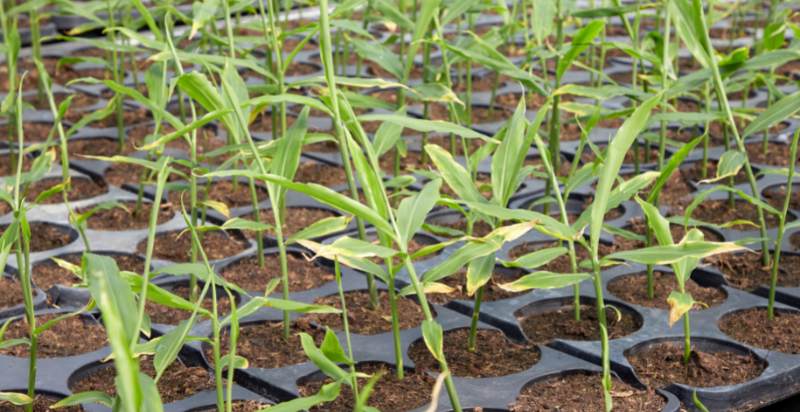
How to Care for Ginger?
Regular care is required to ensure your ginger plants are healthy and growing. Here are some tips for how to best care for your ginger plants:
- Water Regularly: Ensure that the soil around your ginger plants stays moist but not soggy by consistent watering. Do this by checking the moisture content of the soil every few days and adding water if needed.
- Fertilize: To help your ginger plants thrive, fertilize them with a balanced fertilizer about once per month during the growing season. Use a liquid fertilizer or a low-nitrogen granular fertilizer for the best results.
- Mulch: Mulching helps retain moisture and protect young roots from temperature extremes, which are essential for growing healthy ginger plants. Use organic materials such as straw, leaves, or grass clippings to provide a protective layer around the roots of your plants.
- Weed: Keeping your ginger beds free from weeds is important for providing your plants with enough nutrients and sunlight. Hand-weeding or using an herbicide can help keep weeds at bay.
- Prune: Pruning your ginger plants helps promote air circulation and encourages branching for fuller growth. Cut off any dead or dying shoots and remove any leaves that have begun to yellow or brown in color – this will help keep the plant healthy and looking its best!
By following these tips, you can ensure that your ginger plants will be healthy and productive for years. You can enjoy delicious ginger in your recipes all year round with the right care.
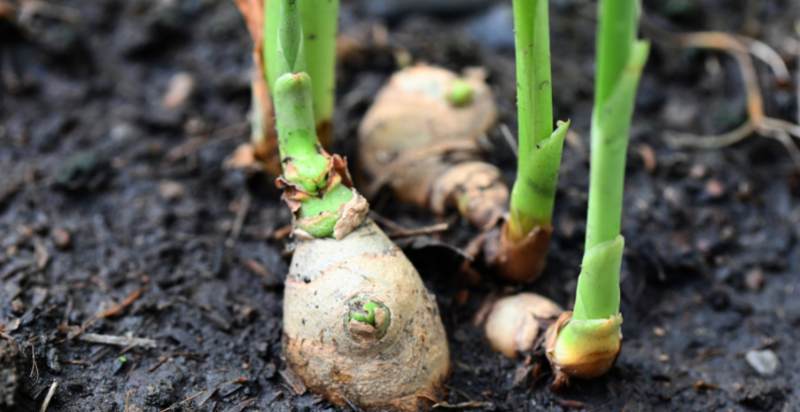
Preventions from Pests and Diseases:
Unfortunately, ginger is prone to several pests and diseases – including root rot, fungal diseases, and aphids. To prevent these issues from occurring, it’s important to practice proper care and maintenance for your ginger plants. Here are some tips:
- Provide adequate spacing between plants: Crowded plants can lead to increased pest infestations and an increased risk of disease transmission. Make sure that each plant has enough room to grow without obstructing another one’s sunlight or airflow.
- Monitor the health of your plants: Regularly inspect your ginger plants for signs of disease, such as yellowing leaves or stunted growth. If you notice any symptoms, take steps to address the issue swiftly.
- Remove any infected plants: If a plant appears to be diseased or infested, it’s important to remove it from your garden to prevent the further spreading of the problem. Dispose of the plant appropriately, and sterilize any tools used in the process!
- Use insecticides or fungicides as needed: Depending on the type of pest or disease present, you may need to use a pesticide or fungicide to control or eradicate them. Always read instructions carefully before applying any products, and follow safety guidelines!
Taking these steps can help ensure that your ginger plants stay healthy and productive for many years.
How to Harvest Ginger?
When it comes to harvesting ginger, you can start when the rhizomes become visible above the soil. Generally, this occurs after about 9-10 months of growing. To harvest your ginger, carefully dig around the base of each plant and loosen the soil with a hand fork or trowel.
Then, gently pull the plants to remove them from their beds without damaging the roots. After that, lay out your harvested ginger in a single layer and allow it to dry for several days until its skin turns brown and brittle – this helps make it easier to peel for use! Once dried, store your ginger in an airtight container in a dark place until ready for use.
You can enjoy a plentiful harvest of delicious ginger year-round with proper care and maintenance.
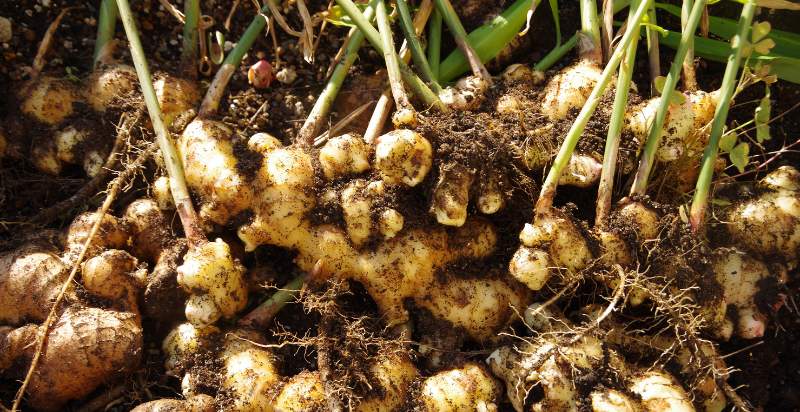
How to store homegrown ginger?
Growing and harvesting your ginger is a great way to enjoy the fresh and flavorful root year-round. To store your homegrown ginger, you’ll need to ensure that it stays dry and away from direct sunlight. Here are some tips for storing your ginger properly:
- Separate the Roots: Before storing your freshly harvested ginger, separate any large clumps of roots into pieces. This will help keep them from sticking together as they dry.
- Place in an Airtight Container: Once separated, place the pieces of ginger in an airtight container or bag and store them in a cool, dark place such as a cupboard or pantry. Be sure to remove any excess moisture – this will help keep the ginger fresh and prevent it from molding or spoiling.
- Use within a Few Weeks: Use your stored ginger within a few weeks of harvesting for the best results. However, if you need to store it longer, you can freeze the ginger for up to six months in an airtight bag or container.
Following these tips, you can enjoy delicious homegrown ginger all year round!
What are the different ways to Incorporate Ginger into your diet?
Ginger is a versatile and flavorful ingredient that can be incorporated into many dishes. Here are some ways to incorporate ginger into your diet:
- Add grated fresh ginger root to soups, stews, stir-fries, curries, or marinades for a spicy flavor boost.
- Infuse ginger in tea or coffee for an energizing beverage.
- Make homemade ginger-infused smoothies for breakfast.
- Roast cubed sweet potatoes with olive oil and shredded ginger for a savory side dish.
- Use ground-dried ginger powder instead of fresh ginger root in recipes such as cookies, muffins, cakes, and quick bread.
- Make a ginger vinaigrette to dress salads, vegetables, and fish dishes.
- Add pickled ginger slices to sushi rolls or fresh salads for flavor and crunch.
- Sprinkle crystallized or candied ginger pieces over ice cream or warm oatmeal for a sweet treat.
- Use freshly grated ginger root in sauces such as teriyaki and hoisin for added flavor complexity.
- Blend freshly made ginger juice with other fruits and vegetables into delicious smoothies or mocktails!
By incorporating these different ways to use ginger into your diet, you can enjoy this tasty spice’s flavors while reaping its many health benefits. So don’t be afraid to get creative and experiment with ginger – it can make a delicious addition to any dish!
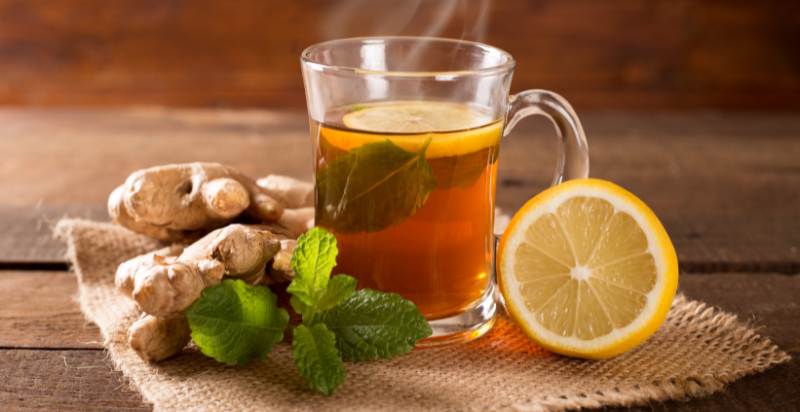
Potential Risks from Ginger:
While ginger is generally regarded as a safe and nutritious ingredient, there are potential risks associated with its consumption. Here are some of the potential health risks to consider when consuming ginger:
1. GI Distress: Eating too much ginger can cause stomach upset, nausea, or diarrhea in some people. This is because ginger contains compounds that can increase the secretion of gastric juices, which may irritate those with sensitive digestive systems.
2. Drug Interactions: Ginger may interact with medications such as anticoagulants or blood thinners, diabetes medications, and aspirin. Before using ginger medicinally or regularly in your diet, it’s always important to consult your healthcare provider first.
3. Allergic Reactions: As with any new food, some people may experience an allergic reaction to ginger, such as a rash or difficulty breathing. If you know you’re allergic to other foods in the Zingiberaceae family (such as turmeric and cardamom), it’s best to avoid eating ginger in large quantities or regularly.
Although these risks may sound scary, consuming ginger in moderation is usually safe for most people. Following food safety guidelines and consulting your healthcare provider if necessary can help ensure that you enjoy the benefits of this delicious spice without putting your health at risk!
In Conclusion:
Growing and incorporating ginger into your diet can be a great way to enjoy this nutritious spice’s unique flavors and its many potential health benefits. Remember to practice moderation, follow food safety guidelines, and consult your healthcare provider to stay safe and healthy. Enjoy!
Happy gardening!
- Everything You Wanted to Know About Red Tamarillos - June 2, 2025
- A Guide to Tulips: Everything You Need to Know & More… - June 2, 2025
- Guanabana: Description, Flavor, Benefits, And Uses - May 27, 2025

13 thoughts on “What is Ginger? How to Plant, Grow, and Harvest Ginger Root ”
Comments are closed.